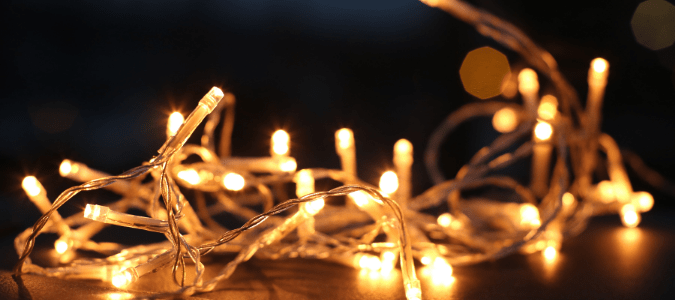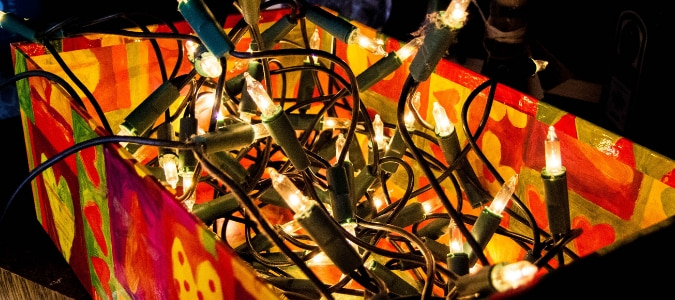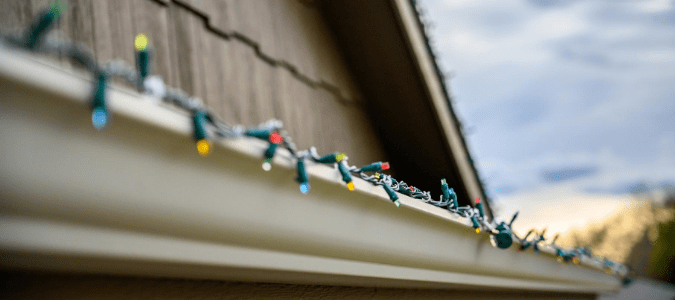
Christmas is typically a joyful time of year, but preparing for the holidays can be incredibly stressful. Every year, homeowners spend hours decorating their house just to realize that a bulb or even a whole strand of lights isn’t working once they plug everything in. Other times, a display works just fine on the first night, and then the lights suddenly go out the next day.
These annoying problems often stem from blown fuses in the lighting system. The main reasons why your Christmas lights keep blowing a fuse include using multiple strands of lights, using the wrong type of lights or using damaged lights.
Using Multiple Strands of Lights
Whether indoors or outdoors, homeowners often string together several strands of Christmas lights when decorating. This can be an efficient method to cover a section of your roof or light the full length of a tall tree. However, if you link too many strands together, it can lead to a frustrating and possibly dangerous situation.
For one, when you plug together multiple strands, this can put an excessive strain on a single power source. When several lights are all trying to draw power from one outlet, it can overload the circuit, resulting in a blown fuse or tripped circuit breaker.
Additionally, blowouts can happen if you plug together several different kinds of lights. Various types of lighting often have a range of amp sizes, which is why chaining these differing types together typically creates power surges and blown fuses.
Using the Wrong Type of Christmas Lights
Some Christmas lights and extension cords are only meant for indoor use, which means they could short out quickly in some outdoor conditions, including rain. Make sure to check the packaging on the holiday lighting you plan to use both in your home and outside to make sure everything is working correctly together.
Using Damaged Christmas Lights
If you have had your Christmas lights for several years, they can suffer damage in storage between uses. Some common issues that can damage lighting include exposure to moisture that corrodes lighting sockets and stretching or breaking of the strand’s wiring system.
You can avoid the stress of having your holiday lights blowing a fuse by hiring a professional holiday lighting company. Not only will this keep you from having to deal with the time-consuming and tedious hassle of broken Christmas lights, but they will also properly store your lights when the holiday season is over, so you don’t have to worry about any damaged lights next year.
If you would like to troubleshoot the issue on your own, there are some basic steps you can take to find what might be the problem. First, try plugging your lights into another outlet to make sure the problem is actually the lights and not a faulty power source. Also, examine the extension cords you’re using for any frayed or broken cords.
Additionally, unplug chains that might have too many strands of lights or a variety of lights and plug them into different outlets. In general, no more than three strands should be linked together. If your Christmas lights came with a user’s manual, check those guidelines on how many strands you can string together. Lastly, gently check each light bulb to make sure it’s secure and replace any broken bulbs.
If you choose to troubleshoot these problems on your own, it’s critical to keep some safety precautions to keep in mind:
- Always unplug your Christmas lights before you start troubleshooting.
- Avoid overloading electrical outlets and extension cords.
- Use gentle pressure with the bulbs, since Christmas lights are fragile and can easily break.
- Make sure the lights and extension cords are away from standing water, rugs, curtains and other potential shock or fire hazards.
After this holiday season is over, there are a few things you can do to help prevent these lighting issues from happening again:
- Remove Christmas lights gently and wrap them loosely to try to prevent stretching or breaking the wiring system.
- Plug in lights and carefully inspect each strand before you start decorating.
- Store your lights in a bag or plastic container with a tight seal to help protect the strands from exposure to humidity or moisture.
- Limit the number of strands that you string together.
- Only link together strands that have the same type of lights.
- Plug lights into the nearest outlet or use an extension cord to keep from breaking wires in the lighting strands.
- For outdoor decoration, plug lights into circuits with a ground fault circuit interrupter (GFCI).
If you decide to go with a professional service, they will not only decorate your home with lights in a way that won’t cause electrical problems, but, as we mentioned before, they will also put your lights away correctly, so you don’t need to worry about any issues next year.
Unfortunately, it can sometimes be difficult to determine what exactly has gone wrong with your Christmas lights, and many homeowners don’t want to run the store to purchase more equipment to figure out what’s going on. Keep reading to learn how you can fix your lights without a tester and what could be going on that is making your LED holiday lights dim.

How to Fix Christmas Lights Without a Tester
Sometimes, a single bad bulb causes a whole strand or a portion of lights to go out. This is most often an issue with older or less expensive lighting. Many newer Christmas light sets come with measures to keep a single bad bulb from affecting the entire strand.
If you see a bulb that is visibly broken, you may have to recycle this strand of Christmas lights. You can also try to look for any bulbs that appear darker than other lights on the strand, which might indicate that one bulb is burned out.
Unfortunately, it’s typically difficult to find the issue by just looking at the lights. One of the most common ways to find a faulty bulb is to use a light tester. This is a tool you can buy at your local hardware store, which illuminates when you’re near a working blub. However, you don’t have to purchase a tester to find the malfunctioning bulb.
Another method is trial and error. If only a portion of the lights isn’t working, mark this off with pieces of tape to help you remember which section is functional. Next, remove a bulb from the nonworking part of your strand, and test it in a light socket that you know is working. Continue this process with each bulb in the nonworking section until you find the broken bulb. When you do, discard the faulty bulb and replace it with a new one.
Unfortunately, identifying broken bulbs is incredibly tedious if you try to do it yourself. When you enlist the help of a pro, someone else can handle the hard work and holiday decorating for you, so you can focus on celebrating with your family and friends.

Why Are My LED Christmas Lights Dim?
Many homeowners have started buying LED Christmas lights because they last longer and are more energy-efficient than incandescent lights. While LEDs usually last longer than other types of lighting, homeowners can still encounter issues with these lights dimming or going out completely.
If the lights are brand new, it’s possible you have a defective strand. Check to make sure you are using the right lights for your environment (for example, don’t use indoor lights outside), and test the individual strand of lights by plugging them into another outlet.
No matter the age of your lights, it’s critical to check your power source. If your lights are plugged into a faulty timer or connected to an overload extension cord, this can cause the lights to dim, and it can pose a serious safety hazard.
For older lights, make sure you’re using the correct replacement bulbs. If you use a lower voltage bulb on a strand that’s rated for higher voltage lights, then the whole strand might appear dim.
Another reason your lights might be dimming is that you have connected too many strands of lights or mixed LED and incandescent lights in a single chain. Electrical current can only reach so far, which means strands at the end of a long chain might appear dim because they aren’t getting the power they need. Additionally, incandescent lights consume much more power than LEDs—when different kinds of lights are mixed, it can cause the LEDs to dim or blow a fuse.
Lastly, it’s possible that it’s time to replace your lights. When LED lights start to get old, they often don’t burn out completely. Instead, LEDs typically start to get dimmer and dimmer to the point where it’s difficult to see them.
No matter your issue, the most efficient and painless way to set up your holiday lights is to hire a professional holiday lighting company. A pro can help take some of the stress out of this busy time of year, so you and your family can just enjoy your beautiful Christmas decorations and spend more time together, whether it’s working on holiday recipes or taking part in another annual tradition.
ABC Can Make the Holiday Season Less Stressful
One of the best holiday hacks is to hire professionals to decorate your home for Christmas. When you contact ABC Home & Commercial Services, we will provide you with new LED lights to decorate any outdoor area you would like, including your roofline, trees and entryways. This way, you don’t have to spend your precious free time learning how to attach Christmas lights to shingles or having a Clark Griswold moment when you plug in your lights and nothing happens. Your home will be beautifully decorated for Christmas and you’ll get more time with family and friends.